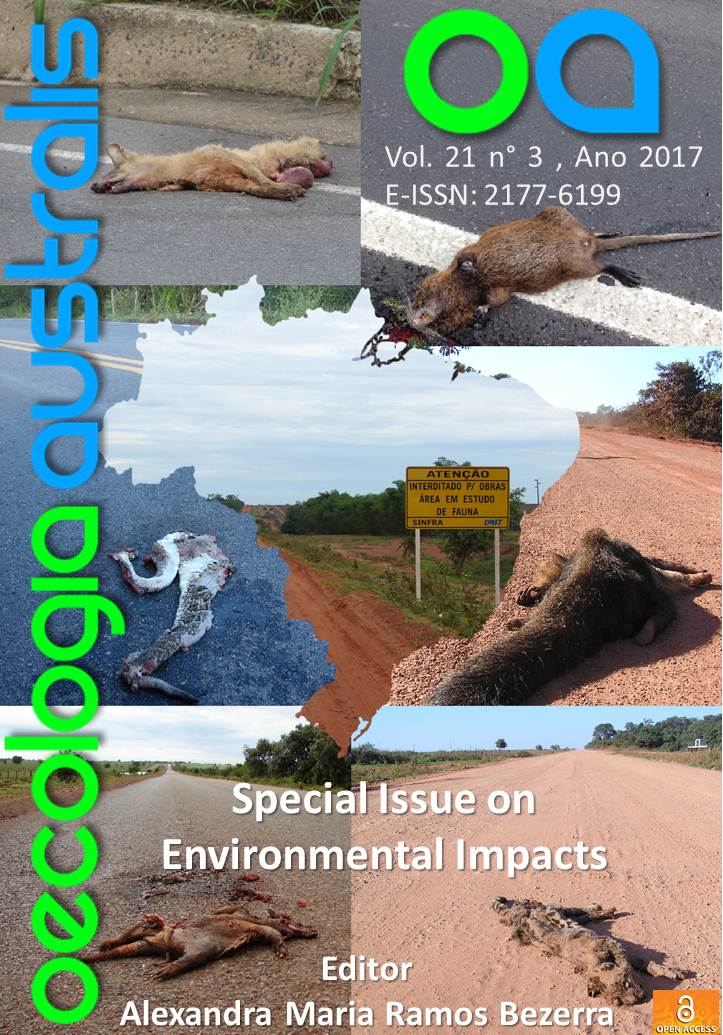TWO-DECADE REMAINING EFFECTS OF BAUXITE TAILINGS ON THE FISH TAXONOMIC STRUCTURE OF A CLEAR-WATER FLOODPLAIN LAKE IN CENTRAL AMAZON (BATATA LAKE, PARÁ STATE, BRAZIL)
DOI:
https://doi.org/10.4257/oeco.2017.2103.08Keywords:
fish assemblage, ichthyofauna, long-term monitoring, mining activities, siltationAbstract
In recent decades, anthropic disturbances have led to major changes in biological communities. Batata Lake (Oriximiná, Pará State, Brazil) is located in the flood area of the right bank of Trombetas River and received effluents rich in mineral waste due to near mining activities in the 80's, which led to the siltation of 30% of its area and numerous local impacts. We monitored about to 20 years the ichthyofauna of Batata Lake and we assessed if there is still remaining effects of the siltation by bauxite tailings in the affected area. We sampled in Silted and Non-Silted areas in the filling period of 1991 to 2015, using a set of gillnets with mesh sizes between 15 to 70 mm. Differences in taxonomic structure (estimated richness, Simpson's dominance and Shannon's diversity) and in community composition among Silted and Non-Silted areas were evaluated with multivariate analysis, considering year as covariate. We sampled 10,435 individuals classified in 141 species. Only 41 species represented 90% of total abundance, which we considered the numerically dominant fishes in the lake. Among taxonomic indices, only estimated richness exhibited a significant trend through time; high estimated richnessin the Silted area during the first years of monitoring and posterior decreasing. This negative slope was highly affected by a single point in 1992, so we considered it a particular case in time and not a real temporal trend. Significant changes in community composition occurred among areas by differentiation in species abundance, and not by species loss. These results show that siltation effects in Batata Lake did not express itself as a loss of biodiversity, but in the reconfiguration of the community composition according to species niche.Downloads
Download data is not yet available.
Downloads
Additional Files
- Table S1. List of species and respective voucher numbers of the 41 most dominant species in the Batata Lake, Pará, Brazil.
- Figure 1 - Batata Lake, Oriximiná Municipality, Pará state, Brazil. The National Forest Saracá-Taquera and the Trombetas River are highlighted, as well as the Silted area of the lake (dotted).
- Figure 2 Total abundance of all species captured in all lake (a), only in the Non-Silted area (b) and only in the Non-Silted area (c) of Batata Lake, Pará state, Brazil. Y axes are shown in logarithmic scale. Dominant species are in the left of the black
- Profile plots comparing estimated richness (a), Simpson's dominance (c) and Shannon's diversity (e) of Silted and Non-Silted areas in the same year, and the temporal pattern of the ratio between Silted and Non-Silted area of estimated richness (b), Simpso
Published
2017-11-10
Issue
Section
Articles


